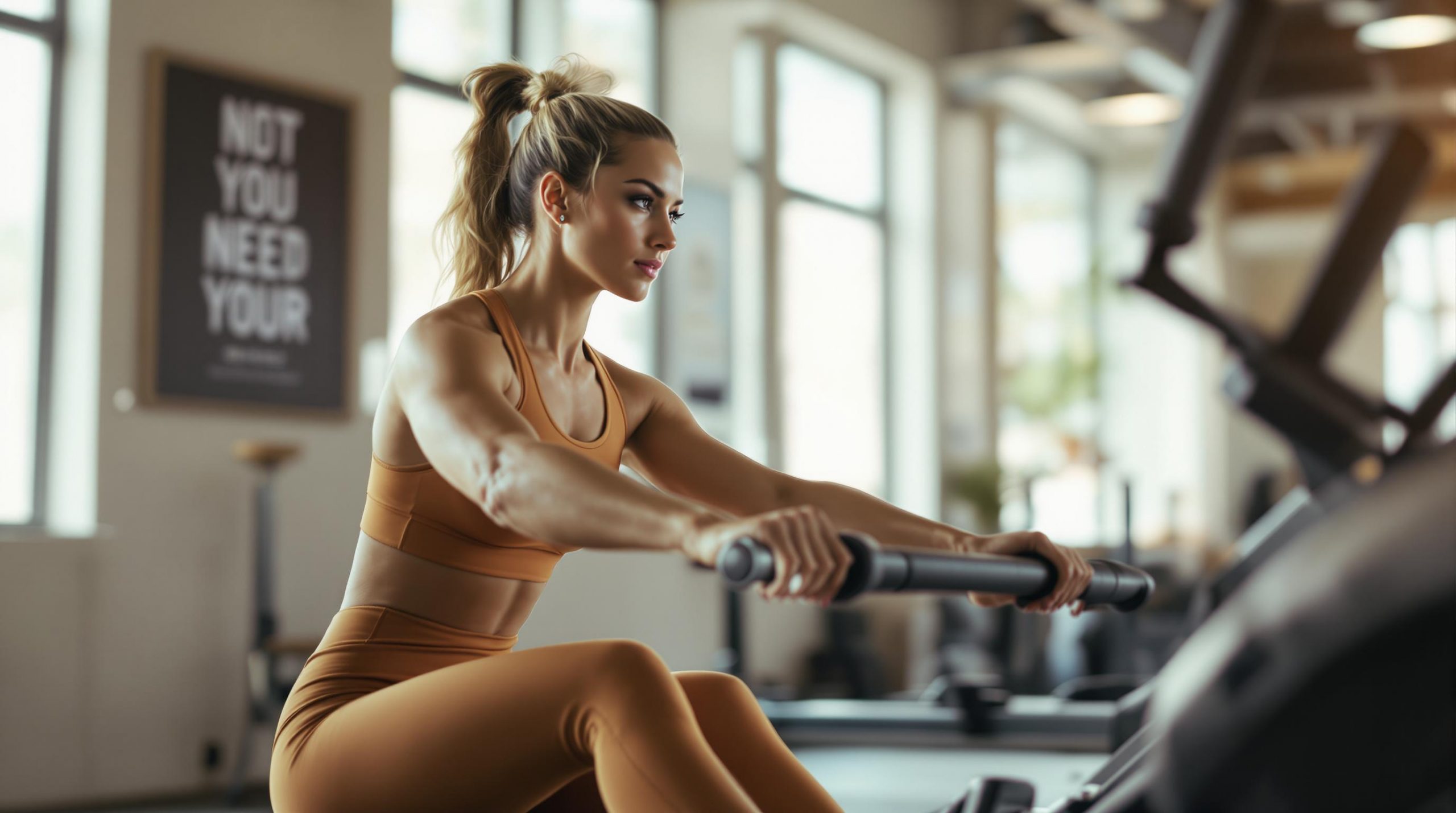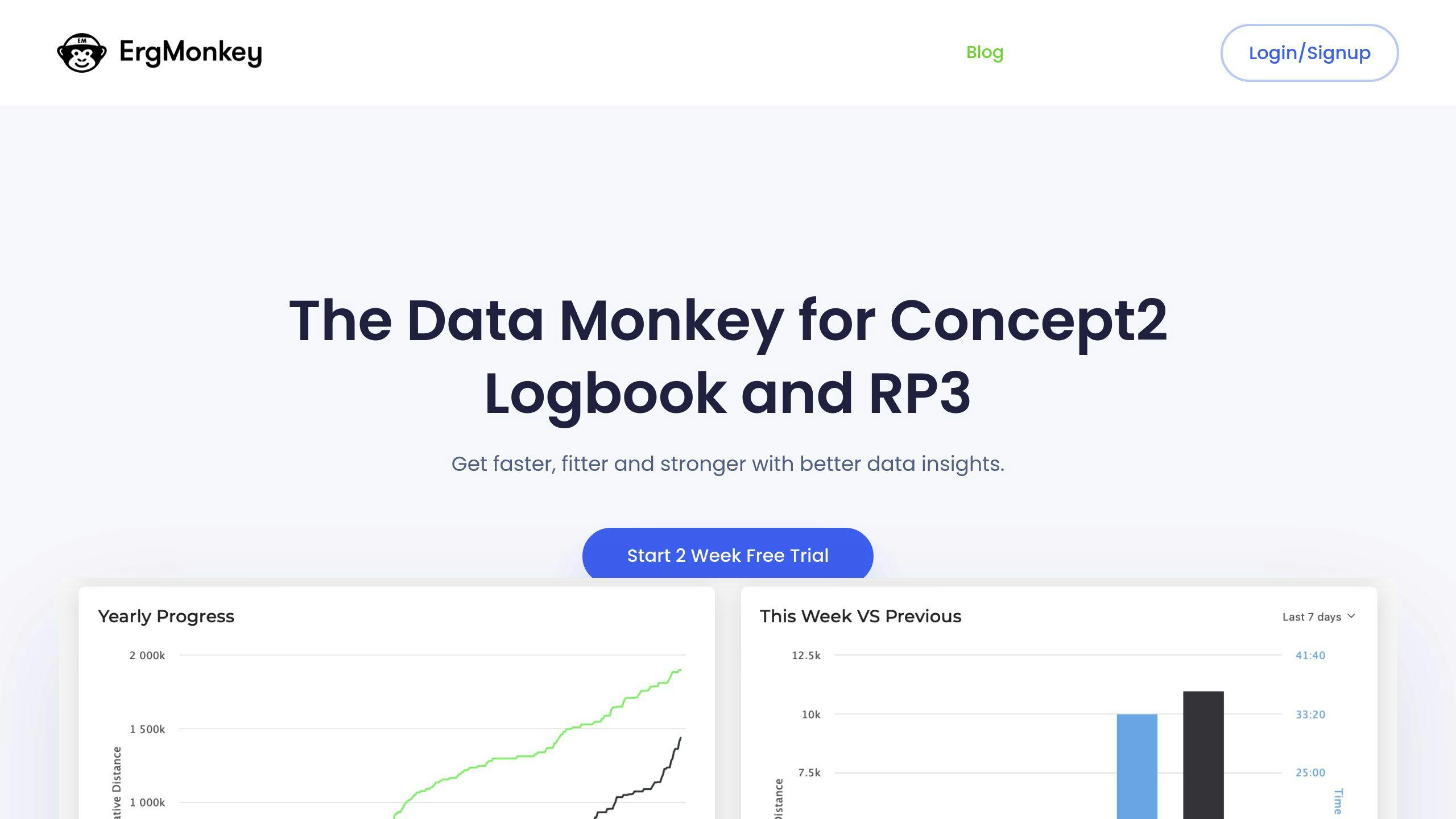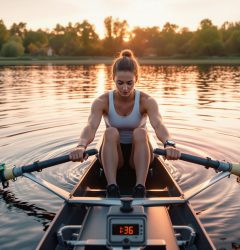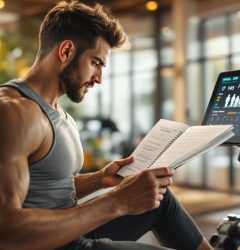04 Feb

Key Benefits of Rowing Drills:
- Better Technique: Focus on proper stroke sequence (legs, body, arms).
- Increased Power: Develop strength with targeted drills.
- Injury Prevention: Practice correct form to reduce strain.
- Muscle Memory: Build consistency for smoother strokes.
Who Can Use These Drills?
- Beginners: Learn basics like legs-only drills and posture.
- Intermediate Rowers: Boost efficiency and endurance.
- Advanced Athletes: Fine-tune for competition with tools like ErgMonkey.
Types of Drills:
- Basic Drills: Legs-only practice, upper body form, and pause positions.
- Advanced Drills: Rate ladder workouts, power sets, and blind rowing.
Quick Tips:
- Use tools like ErgMonkey to track metrics (split times, stroke rate, heart rate zones).
- Record and review your rowing technique weekly for improvement.
- Combine drills with endurance and power workouts for balanced training.
Start incorporating these drills into your routine to improve both technique and fitness. Whether you’re a beginner or advanced rower, structured practice leads to measurable progress.
20 Min Intermediate Rowing Machine Drills
Basic Technique Drills
These drills are the foundation for rowers at any level, breaking down the rowing stroke into smaller parts. By focusing on each element individually, you can fine-tune your form and build a smooth, effective stroke.
Legs-Only Practice
This drill zeroes in on the leg drive, which is the strongest part of the stroke. It helps correct the common mistake of relying too much on arm strength.
Start in the catch position with your arms straight and your body leaning slightly forward. Push off using your legs while keeping your arms straight and your body steady. Return to the catch position and repeat for 15-20 strokes. This helps develop muscle memory for a leg-focused stroke, following the British Rowing Technique guidelines for proper stroke sequence [4].
Upper Body Form
This drill focuses on upper body mechanics, helping you refine posture and arm movement. Begin with your legs straight, torso leaning forward, and arms fully extended. Concentrate on using your back to pull the handle toward your chest, avoiding early arm bending. Practice this for 15-20 strokes to improve your upper body technique [3].
Pause Position Training
Pause position drills improve control and awareness during different points of the stroke. Pause for 2-3 seconds at key positions – Finish (arms pulled in, legs extended), Hands Away (arms extended, torso leaning back), and Body Over (torso leaning forward) – to check and adjust your form [3].
For tracking your progress and analyzing your strokes, tools like ErgMonkey can offer helpful insights. Once these drills feel natural, you’ll be ready to move on to exercises designed to build strength and stamina.
High-Level Training Drills
These advanced exercises are designed to boost power, build endurance, and fine-tune your stroke technique.
Rate Ladder Workouts
This drill uses a gradual increase in stroke rate to improve both control and stamina.
Here’s a typical session:
- 5 minutes at 18 strokes per minute: A warm-up pace to establish rhythm and prepare your muscles.
- 5 minutes at 20 strokes per minute: A moderate pace to enhance endurance.
- 5 minutes at 22 strokes per minute: A more challenging pace to focus on maintaining power.
The key is to keep your power output and form steady as the stroke rate rises. Tools like ErgMonkey’s heart rate zone analysis can help you stay in the right intensity range throughout.
Power-Building Sets
These sets are all about maximizing power. Perform 3 sets of 20 high-power strokes, followed by 10 minutes of steady-state rowing at 20 strokes per minute. Take a 2-minute recovery between each set. This workout is great for improving race-day performance and overall strength.
During these bursts, focus on proper technique. Most of your power should come from a strong leg drive, with your upper body staying controlled and efficient.
Blind Rowing Practice
This drill involves rowing with your eyes closed or using a blindfold for 2-3 minutes. It sharpens your ability to maintain consistent drive pressure and use the sound of the flywheel for feedback.
To get the most out of this practice:
- Start with short intervals (2-3 minutes).
- Focus on keeping your drive pressure steady.
- Listen closely to the flywheel sound for rhythm and consistency.
- Use a blindfold or simply close your eyes.
Track your progress with tools like ErgMonkey to analyze stroke data and pinpoint areas for improvement. This method allows you to make targeted adjustments to your training.
Adding these drills to your routine will help you see measurable improvements in your performance over time.
sbb-itb-1725142
Building a Drill Program
Creating a rowing drill program that delivers results takes thoughtful planning and regular monitoring. Here’s how to set up your training for success.
Workout Examples
For those just starting or at an intermediate level:
| Level | Focus | Duration | Details |
|---|---|---|---|
| Beginner | Basic Form | 30 min | Legs-only practice |
| Beginner | Endurance | 45 min | 3x1500m in Zone 3, 60-sec rest |
| Beginner | Power | 40 min | 8x500m in Zone 3-4, 30-sec rest |
For intermediate rowers looking to step up:
- Technical Development: Include 4 sets of pause drills and 20 minutes of steady-state rowing at 18-20 strokes per minute.
- Power Training: Add high-intensity power sets while gradually reducing rest as your fitness improves.
- Endurance Work: Aim for 6,000-12,000 meters at a steady pace, staying in Heart Rate Zone 3.
Progress Measurement
Keep track of your improvement by focusing on these metrics:
- Split Times: Log your 500m splits to monitor speed and efficiency.
- Stroke Rate Consistency: Check how well you maintain your target stroke rate.
- Heart Rate Zones: Measure time spent in each heart rate zone for better insight into endurance and recovery.
"By paying attention to your split time, you can gauge your speed and efficiency and make necessary adjustments to improve your performance." [1]
To get even more precise feedback, consider using tools like ErgMonkey to analyze your performance.
Using ErgMonkey for Analysis

ErgMonkey is a powerful tool for rowing drills, tracking critical metrics like split times and heart rate zones. Its detailed analysis features allow you to fine-tune your training and make smarter adjustments based on your data.
Problem-Solving Guide
Rowing with poor form can hurt your performance and increase the chance of injuries. Let’s look at practical ways to correct common mistakes and keep track of your progress.
Fixing Form Mistakes
Issues like starting the stroke with your arms or maintaining poor posture can be improved with specific drills. For instance:
- Legs-Only Practice helps you focus on a strong leg drive.
- Reverse Pick Drill breaks the stroke into smaller parts, making it easier to fine-tune your technique.
- Pause Position Training (covered earlier) is great for fixing posture problems.
Remember, the ideal stroke sequence is legs, body, arms during the drive and arms, body, legs during recovery. Following this order not only boosts efficiency but also reduces stress on your back and shoulders.
"By focusing on one aspect of the stroke at a time and using slow-motion playback to analyze technique, rowers can significantly improve their overall efficiency" [1]
Recording and Review
Set aside 5 minutes each week to record your rowing from both side and front angles. Apps like Hudl Technique let you slow down the footage for detailed analysis. While reviewing, pay close attention to:
- Catch Position: Are your shins at the right angle? Are your arms fully extended?
- Drive Phase: Is the power sequence – legs, body, arms – correct?
- Recovery: Is your movement smooth and controlled as you return to the catch?
Video analysis gives you clear visual feedback, making it easier to spot areas for improvement. Over time, this can help you refine your form and see measurable progress, like better split times.
"Regular video analysis can provide visual feedback on technique improvements. For instance, if a rower notices a decrease in their average split time after implementing form corrections, it indicates an improvement in their rowing efficiency" [2]
Conclusion
Improving in rowing requires structured drills and consistent practice. Whether you’re focusing on the basics or tackling advanced exercises, a well-organized training plan enhances both technique and physical fitness.
Main Points
Good technique is the backbone of successful rowing, and drills are crucial for refining the stroke sequence. With advancements in technology, tools like ErgMonkey now allow rowers to monitor their progress and adjust their training with precision.
To get the most out of rowing drills, focus on regular practice, gradually increasing intensity, and using data to guide your efforts. This method not only tackles common technical issues but also builds strength and stamina over time.
"Regular video analysis can provide visual feedback on technique improvements. For instance, if a rower notices a decrease in their average split time after implementing form corrections, it indicates an improvement in their rowing efficiency" [2]
Incorporating tools like ErgMonkey into your routine helps ensure your training is targeted and productive. Combining well-executed drills with consistent tracking leads to noticeable gains in both skill and physical performance.
FAQs
What is the best interval workout for rowing machine?
One of the most effective interval workouts for a rowing machine is the Tabata workout, a high-intensity interval training (HIIT) protocol. Here’s how it works:
- 8 rounds of 20 seconds of all-out rowing
- 10 seconds of easy rowing between rounds
- A 5-minute cool-down after completing the intervals
- Optionally, take a 2-minute break and repeat the set if you’re up for it
Tabata is known for improving anaerobic capacity and building muscular endurance in a short amount of time. To get the most out of it – and to stay safe – focus on proper rowing technique. This means keeping your back straight, engaging your core, and driving the stroke with your legs before involving your back and arms.
"Proper technique is crucial for maximizing the effectiveness of interval workouts. Incorrect technique can lead to inefficiency and increased risk of injury. Key elements include maintaining a straight back, engaging the core, and using the legs to initiate the stroke, followed by the back and arms." [1]
Using tools like ErgMonkey can help you analyze your Tabata sessions by tracking split times, heart rate zones, power output, and recovery. These insights can guide your progress and fine-tune your training.
For the best results, warm up thoroughly, stay consistent with your timing, and monitor your form throughout the workout. Beginners might want to start with longer rest periods and gradually work up to the standard Tabata format.
Adding Tabata to your routine can greatly improve your rowing performance, especially when combined with the technical drills and power-building exercises discussed earlier in this guide.


